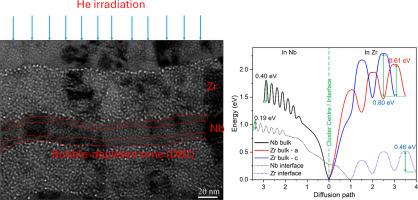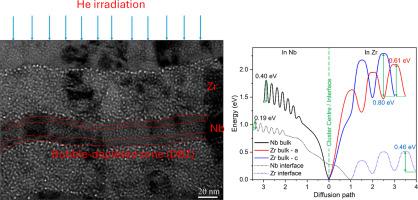HCP/BCC Zr/Nb多层界面的不对称缺陷吸收行为:Nb层的气泡剥蚀区
IF 9.3
1区 材料科学
Q1 MATERIALS SCIENCE, MULTIDISCIPLINARY
引用次数: 0
摘要
辐射诱导氦(He)气泡的形成对核能系统中材料的结构完整性提出了重大挑战。在这项研究中,我们研究了具有不混相BCC/HCP界面的Zr/Nb纳米级金属多层膜(nmm)的缺陷演变和He行为,并在1 × 10¹⁶至1 × 10¹⁷ He/cm²的影响范围内用80 keV He离子照射。为了比较,在相同的条件下辐照单晶Nb和多晶Zr作为对照物质。利用横截面TEM、SIMS、STEM-EELS、纳米压痕、多普勒增宽正电子湮灭光谱(DBPAS)、正电子湮灭寿命光谱(PALS)和原子模拟(DFT和MD),我们揭示了多层界面上高度不对称的损伤响应。Zr层表现出更大的He气泡(1.5-2.8 nm),更高的膨胀(~ 1.2%)和更大的氦保留,而Nb层只在界面周围发育气泡剥蚀区(BDZs),在那里气泡成核被强烈抑制,膨胀被限制在~ 0.4%。这种不对称性源于原子输运性质的差异:DFT计算显示,Nb中空位和He原子的迁移势垒较低(分别为0.4和0.19 eV),从而在界面处实现了有效的缺陷迁移和重组,而Zr由于更高的迁移势垒而保留了缺陷。EELS和DBS-PALS测量证实气泡密度为63-96 He/nm³,并且存在亚纳米级的开放体积。与单片样品相比,Zr/Nb多层样品的辐照诱导硬化降低了50%,He保留率降低了11%,单晶Nb为17.5%,多晶Zr为16%。这些发现强调了界面在驱动不对称辐射损伤中的作用,并证明了BCC Nb层在减轻缺陷生长方面的有效性。总的来说,Zr/Nb多层材料是传统单晶和多晶材料在极端辐照环境下的优越替代品。本文章由计算机程序翻译,如有差异,请以英文原文为准。


Asymmetrical defect sink behavior of HCP/BCC Zr/Nb multilayer interfaces: Bubble-denuded zones at Nb layers
Radiation-induced helium (He) bubble formation poses a major challenge to the structural integrity of materials in nuclear energy systems. In this study, we investigate defect evolution and He behavior in Zr/Nb nanoscale metallic multilayers (NMMs) with immiscible BCC/HCP interfaces, irradiated with 80 keV He ions at fluences ranging from 1 × 10¹⁶ to 1 × 10¹⁷ He/cm². For comparison, single-crystal Nb and polycrystalline Zr were also irradiated under identical conditions to serve as reference materials. Using cross-sectional TEM, SIMS, STEM-EELS, nanoindentation, Doppler Broadening Positron Annihilation Spectroscopy (DBPAS), Positron Annihilation Lifetime Spectroscopy (PALS), and atomistic simulations (DFT and MD), we reveal a highly asymmetric damage response across the multilayer interfaces. Zr layers exhibit larger He bubbles (1.5–2.8 nm), higher swelling (∼1.2%), and greater helium retention, while Nb layers develop bubble-denuded zones (BDZs) exclusively around the interfaces, where bubble nucleation is strongly suppressed and swelling is limited to ∼0.4%. This asymmetry arises from differences in atomic transport properties: DFT calculations show lower migration barriers for vacancies and He atoms in Nb (0.4 and 0.19 eV, respectively), enabling efficient defect migration and recombination at interfaces, whereas Zr retains defects due to higher migration barriers. EELS and DBS-PALS measurements confirm bubble densities of 63–96 He/nm³ and the presence of sub-nanometer open volumes. Compared to monolithic samples, the Zr/Nb multilayers exhibit ∼50% lower irradiation-induced hardening and reduced He retention (11% vs. 17.5% in single-crystal Nb and 16% in polycrystalline Zr). These findings highlight the role of interfaces in driving asymmetric radiation damage and demonstrate the effectiveness of BCC Nb layers in mitigating defect growth. Overall, Zr/Nb multilayers are established as a superior alternative to conventional single- and polycrystalline materials for extreme irradiation environments.
求助全文
通过发布文献求助,成功后即可免费获取论文全文。
去求助
来源期刊

Acta Materialia
工程技术-材料科学:综合
CiteScore
16.10
自引率
8.50%
发文量
801
审稿时长
53 days
期刊介绍:
Acta Materialia serves as a platform for publishing full-length, original papers and commissioned overviews that contribute to a profound understanding of the correlation between the processing, structure, and properties of inorganic materials. The journal seeks papers with high impact potential or those that significantly propel the field forward. The scope includes the atomic and molecular arrangements, chemical and electronic structures, and microstructure of materials, focusing on their mechanical or functional behavior across all length scales, including nanostructures.
 求助内容:
求助内容: 应助结果提醒方式:
应助结果提醒方式:


